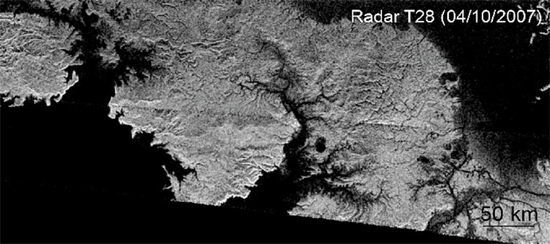Oct 10, 2013
Do the centers of planets and moons contain rocky slush or molten magma?
A gravity map of Titan, created by monitoring changes in the Cassini orbiter’s speed as it flew by the giant moon between February 2006 and July 2008, indicates that its interior is a mixture of rock and ice with no layering. The orbital variations were measured by the Earth-based Deep Space Network as Titan’s gravity “pushed and pulled” Cassini in its flight path. Analyzing those gravitational tics provides data for computer models of Titan’s core.
Since the variations in gravity suggest a variation in density, and that variation is so subtle, there are no “mascons” of rock distributed through Titan’s body as there are inside Earth’s Moon. Instead, the rocks and ice are thought to be compacted into a relatively homogeneous interior structure. However, this analysis is based on no real understanding of gravity.
As written in previous Picture of the Day articles, many of Titan’s anomalies can be explained if a youthful aspect is considered. Titan might only be a few thousand years old and not the billions of years required by conventional astrophysics, so the presence of its dense atmosphere, lacking a mechanism for replenishment, can be attributed to that youth. Since Titan is relatively young, its atmosphere is not in equilibrium, it is losing methane at a measurable rate. That atmospheric loss would require methane production somewhere on or in the moon’s body if it is ancient.
The canyons and “rilles” on Titan’s surface are thought to be “drainage channels” from the methane rains that must (presumably) periodically fall to feed the “rivers,” although no precipitation was detected by the Huygens lander. It is also questionable whether non-polar methane can form an erosive rain like the remarkable electric dipolar water molecule. But rain of any kind is not necessary to explain the channels on Titan. In an Electric Universe the channels are blast marks etched into Titan’s surface from tremendous lightning discharges that point to the moon’s savage electrical birth. Their dendritic forms are called Lichtenberg figures.
A recent electrical birth from Saturn may explain Titan’s homogeneous core. Electric Universe theory proposes that the progeny of stars or gas giant planets are not all born at the same time as the parent. They are born hierarchically at intervals by parturition from the electrically stressed parent body. As one physicist explained, “All of the existing theories of planet formation have taken material from the surface of the Sun or from a cloud of dust outside the Sun in order to form the planets, for the ‘obvious’ reason that planets are on the outside of the Sun. We humans, equally ‘obviously,’ are outside our mothers – yet we did not start there.” There is currently no satisfactory gravitational accretion model of planet formation.
If Titan was ejected from Saturn in a paroxysm, then its atmosphere, surface features, and core are the results of that catastrophic event. And since the mass of any stellar or planetary body is a variable depending on internal electrical stress, no conclusions can be drawn about the composition of Titan’s core. The small effects on Cassini could be due to electrical inhomogeneities in Titan.
Wal Thornhill
Stephen Smith
Click here for a Spanish translation













